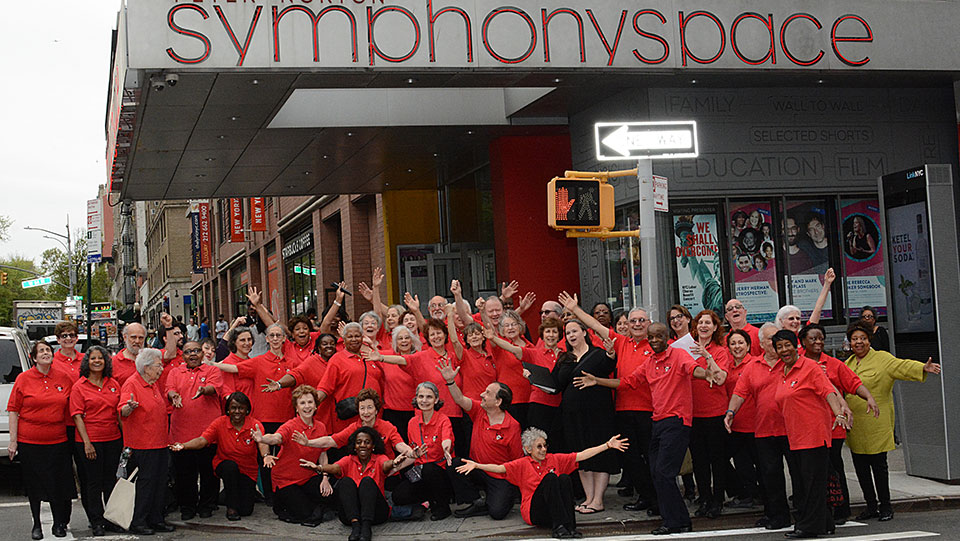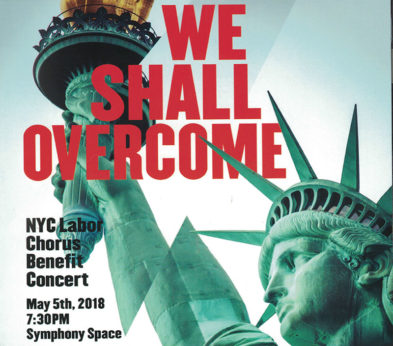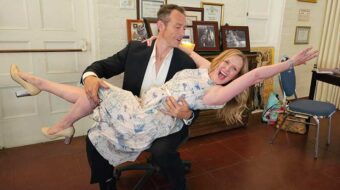
I’ve lost track of how many CDs the New York City Labor Chorus has produced so far, but at least three previous ones are listed on their website. Listeners can count on this amateur, but hardworking and passionate, multi-ethnic and multi-generational group of 75-80 members representing 20 union locals, to deliver the vocal goods. Their varied and well-chosen repertoire reflects the diversity within the chorus and within the labor movement.
The ensemble’s latest CD, We Shall Overcome, released in 2019, is taken from a live concert at Symphony Space on Manhattan’s Upper West Side, on May 5, 2018. Just a few weeks before, on April 4, the world commemorated the 50th anniversary of the assassination of Dr. Martin Luther King Jr. The concert and the album honor his “radiant legacy.” In the words of the album liner notes, “This magnificent non-violent warrior for equality, peace, and justice was killed exactly one year after making his courageous speech against the U.S. war in Vietnam.
“He devoted his life to the struggle against what he called ‘the evil triplet of racism, materialism, and militarism.’ We dedicate ourselves to continuing the fight against this evil triplet which has led us into the terrifying and self-perpetuating war on terror and given rise to a Donald Trump….
“We close with Dr. King’s eloquent words: ‘Returning hate for hate multiplies hate, adding deeper darkness to a night already devoid of stars. Darkness cannot drive out darkness, only light can do that. Hate cannot drive out hate: only love can do that.”
 The CD cover, designed by Laura Tolkow, features an image of the Statue of Liberty that graphically tells a great deal about the contents inside. The Lady of the Harbor lifts her golden lamp high, but her arm has been graphically altered, fractured, shattered, as indeed American democracy has become in recent years. Yet she has recovered sufficiently to once again raise the torch for all the world to see. There is no mistaking the message: The labor movement, represented by the 19 numbers on this 70-minute CD, will be amongst the leading forces healing the nation, welcoming the newcomer, and restoring its working women and men to a place of dignity and pride.
The CD cover, designed by Laura Tolkow, features an image of the Statue of Liberty that graphically tells a great deal about the contents inside. The Lady of the Harbor lifts her golden lamp high, but her arm has been graphically altered, fractured, shattered, as indeed American democracy has become in recent years. Yet she has recovered sufficiently to once again raise the torch for all the world to see. There is no mistaking the message: The labor movement, represented by the 19 numbers on this 70-minute CD, will be amongst the leading forces healing the nation, welcoming the newcomer, and restoring its working women and men to a place of dignity and pride.
Bev Grant’s song “We Were There” salutes all those workers in every sector of the economy who were present and accounted for, everywhere and always, at countless righteous struggles over the decades, and also pulling for America’s prosperity every day just by showing up on the job. This number is something of a latter-day version of the famous Ballad for Americans cantata by Earl Robinson and John Latouche, made famous in live performances and recordings by Paul Robeson and many other soloists.
Choral music is, of course, the main dish served on this CD, but there is one exception: Cut 9 features Tom Karlson reading his short poem “Twenty-Seven Years,” capturing the spirit of the chorus since its auspicious founding in 1991:
twenty-seven years of singing
songs of labor, civil rights, women’s rights
songs to fight the horrors of war
nuclear war, drone war, all war
singing to save mother earth
songs from gospel
songs for marching, the picket line
sweet songs of labor and love
more than a quarter century
of battling injustice with song
the new york city labor chorus
We Shall Overcome features a number of classic labor and movement songs, such as the album title as the finale, which is still and forever uplifting and necessary, especially thinking about the role labor continues to play in the claim to full democracy for all in the current era. By the time I got to the audience participation-enhanced verse “We are not afraid,” I have to admit my eyes welled up feeling the depths of meaning attached to this song and its continuing relevance.
Other familiar numbers include what they title “Rocking Solidarity Forever,” an R&B gospel version, with Denise Jones’s powerful solo, that sounds as though the NYCLC had been interning with one of Harlem’s premier choirs. That flava is what you get with such a variegated membership, as the NYCLC has.
Other well-known songs are the Mimi Fariña version of “Bread and Roses,” set to the 1911 poem by James Oppenheim (though weirdly the CD, and the printed program from the concert, refers to him as Joel Oppenheimer), the Bertolt Brecht-Hanns Eisler song “United Front,” and “Give Me Your Tired, Your Poor” by Irving Berlin set to words of Emma Lazarus on the Lady Liberty’s pedestal (oh, when will America start honoring those words again?).
Popular, though never outworn, is John Lennon’s “Imagine,” perhaps everybody’s favorite secular anthem with its timeless lyrics, although the CD has not updated its credit to include Yoko Ono as co-creator of the song. The CD includes that lovely paean to music and song by the American Baptist minister Robert Lowry, “How Can I Keep From Singing?” with words by Doris Plenn, Pete Seeger, and chorus member Jeff Vogel (it is not, as is often claimed, a Quaker tune, though Quakers, among others, have adopted it into their hymnbook). Pete Seeger makes another appearance on the CD with his prayer-like environmental song “To My Old Brown Earth,” whose words, alas, I found difficult to understand in this choral setting. The CD packaging does contain two song texts, plus the Karlson poem, but I would have appreciated a fuller supply of lyrics.
A quite rousing version in both Spanish and English of Sergio Ortega’s “El Pueblo Unido” (The People United) will get anyone chanting along with the stirring slogan “el pueblo unido jamás será vencido” (the people united will never be defeated) that has become an international call for unity in struggle (and do we ever need plenty of that right now). The chant has been translated into many languages by now: In case you’re interested, not long ago I learned the Yiddish version, Dos folk in eynem vet nit bazigt fun keynem.
Another couple of numbers that listeners may recognize are “Do You Hear the People Sing?” from the worldwide hit musical Les Misérables, and the song “Ain’t You Got a Right (to the Tree of Life)?” which originated in the South Carolina Gullah culture but which achieved a new level of importance in the civil rights movement. In this latter song I found the NYCLC arrangement among the standouts of the album with its superimposed contrapuntal effects. And you may recognize the song “Glory” from the film Selma, performed to the accompaniment of very contemporary rap resistance poetry. Gwen Davis and Lamique Johnson give us their piercing solo voices on this cut.
The CD opens with the Mariachi Infante group performing “Viva México” by Pedro Galindo Galarza, who were clearly a hit with the audience. The lyrics also say, “Viva América,” signifying that immigrants from Mexico, other countries in Latin America and the Caribbean, and indeed from every corner of the globe, have contributed to the growth and power of the United States, despite the slanders the current administration (and others before this one) has thrown against those who come to remake their lives on our shores.
Old tunes made new
Two cuts on the CD will be instantly recognizable to almost any listener: The “Hallelujah” chorus from Händel’s Messiah is one, but fitted out with a new text by Jeff Vogel as “Life on Earth, So Amazing”:
Life on Earth,
So amazing, so amazing.
Orbiting ’round a golden sun,
So amazing, so amazing.
The radiance of the sun
Shines on all the creatures of the Earth,
And of the sea, and of the sky.
And peace shall reign forever and ever.
Hallelujah, Hallelujah.
Peace on Earth, forever and ever
And war no more, forever and ever.
And peace shall reign forever and ever.
All for one, and one for all.
And peace shall reign forever and ever. Hallelujah….
The other number derived from classical music is “Song of Peace,” whose melody is that of Jean Sibelius’s Finlandia. The new words, dating back to the 1930s, are by Lloyd Stone and Georgia Harkness. It sounded very lovely, but I could not distinguish the words; a quick internet search found them:
This is my song, O God of all the nations,
a song of peace for lands afar and mine;
this is my home, the country where my heart is;
here are my hopes, my dreams, my holy shrine:
but other hearts in other lands are beating
with hopes and dreams as true and high as mine.
My country’s skies are bluer than the ocean,
and sunlight beams on cloverleaf and pine;
but other lands have sunlight too, and clover,
and skies are everywhere as blue as mine:
O hear my song, thou God of all the nations,
a song of peace for their land and for mine.
May truth and freedom come to every nation;
may peace abound where strife has raged so long;
that each may seek to love and build together,
a world united, righting every wrong;
a world united in its love for freedom,
proclaiming peace together in one song.
And so the internationalism, both of the labor movement in general and of New York’s labor chorus in particular is further underlined.
Encouraging activism
The chorus has already shown its love for the Earth and all creation, but a contemporary number by singer/songwriter Fred Small totally nails their earnest commitment. “Three Five O” was new to me. The title refers to the parts per million of CO2 that climate scientists believed we should restrict ourselves to if we are to avoid the permanent consequences of catastrophic climate change. According to the program book which I received along with the CD, that number has already been surpassed (it’s now 409 ppm), “the song still represents an aspirational goal of limiting carbon dioxide…emitted into the atmosphere.” Just one verse and the chorus here:
For the snows of Kilimanjaro, three five o.
For the children who will follow, three five o.
For the seasons ever turning, for the ancient forests burning,
Seize the number, heed the warning, three five o.
Step it up, we can’t slow down now, take my hand and don’t let go.
Got to make it to higher ground now. Three five o.
The song has the lilting charm of a sailors’ sea shanty, reflecting references in later verses to “glaciers melting, oceans warming…cities flooding…storm tide rising.” For me this is a highlight of the CD, in part because I had never heard it before, and because it seems to elicit the ensemble’s best talents.
Finally, another song I did not recognize (though I should have!) is “Make Them Hear You,” words by Lynn Ahrens and music by Stephen Flaherty. It’s from the musical Ragtime, but that source was unfortunately left off the CD. Aaron Schweitzer has a hearty proletarian solo on this one. The insistence to be heard reminds me of the anecdote—which is possibly apocryphal but needs to be remembered as part of metahistory if nothing else—about an encounter between the Black labor and civil rights leader A. Philip Randolph and President Franklin D. Roosevelt. World War II was looming and Randolph sought the president’s commitment to enact anti-discrimination laws. Reportedly, FDR replied, “I agree with you, now go out and make me do it.”
Jana Ballard is the NYCLC’s musical director, a member of the United Federation of Teachers and a faculty member since 2007 at LaGuardia High School of Music & Art and Performing Arts. Accompanist Dennis Nelson is a member of Local 802 of the American Federation of Musicians and is the music director at Trinity Baptist Church in Brooklyn. Almost all the singers are union members, and are identified as such in the program.
The printed program for the 2018 concert, which those who acquire the CD will not receive, is truly remarkable. It contains not only a list of the numbers performed, a timeline of the chorus’s achievements, bios of the chorus leaders, a roster of members, and the full lyrics to “Three Five O,” but it is anchored as well by full-page letters of greeting from four of the five New York City Borough Presidents (only Staten Island is missing) and from Mayor Bill de Blasio. The mayor congratulates the chorus “for all they do to empower our diverse residents, uphold our progressive values, and move our great city forward.” Ads from individuals, businesses, law firms, and especially from unions themselves attest to the widespread community support the chorus enjoys.
I’ve remarked that lyrics are not always readily understood, except in the two instances where they are provided; maybe a lyrics insert in the CD would be helpful. In one other aspect I think there is room for advancement: The dominant musical esthetic—and here, of course, I am not speaking of the admirable social and political content of the CD—is conservative, opting in almost every piece for the kinds of standard harmonic resolutions found in popular music and in church or school hymnals and songbooks. I do appreciate that this is an amateur ensemble, not one of professional singers, yet I do believe they are capable of stretching a little for a spicier, more daring, and artistically interesting sound with greater rhythmic variety and snap.
Still, in all, it’s a highly satisfying and recommended listening experience suitable for home or office—and great to take along on road trips once the country starts moving again. The chorus office is closed during the pandemic, so to order a copy send a $15 check payable to NYC Labor Chorus to: Jeff Vogel, 4801 42nd St., #4D, Sunnyside, NY 11104.












Comments